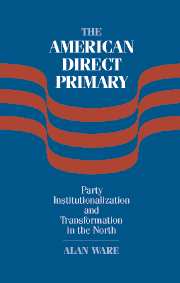Book contents
4 - The Spread of Direct Nominations
Published online by Cambridge University Press: 16 July 2009
Summary
The transformation in the nominating process evident in most American states between the 1880s and 1915 was characterized by two developments that began quite separately and then converged. One was discussed in the last chapter: the switch from informal procedures to legal control of the process. The other was the replacement of party caucuses and conventions by direct party elections as the means of selecting candidates. The first development did not entail the second, and, in theory at least, one might have happened without the other. Legal control of candidate selection did not require the use of elections; while the use of elections would have necessitated a move away from wholly informal procedures, logically there was no reason why such elections could not have been conducted under party rules rather controlled by state law. (Indeed, this was practiced in some states.) However, it was the convergence of the two developments that was to create the distinctively American nominating system of the early-to-mid-twentieth century.
This last point is important because one of the reasons that the rise of the direct primary has been misunderstood is that often the two developments are conflated. For example, Austin Ranney has claimed that “[S]trictly speaking, a direct primary is a system in which political parties are required by law to choose their candidates through state-administered elections in which any legally qualified person must be allowed to vote.”
- Type
- Chapter
- Information
- The American Direct PrimaryParty Institutionalization and Transformation in the North, pp. 95 - 128Publisher: Cambridge University PressPrint publication year: 2002



